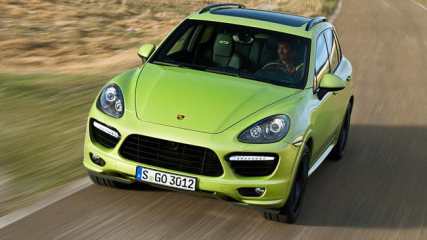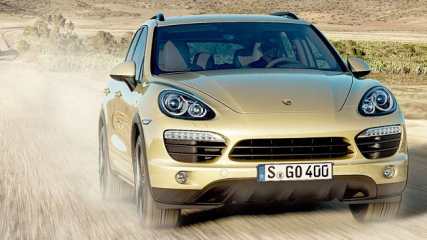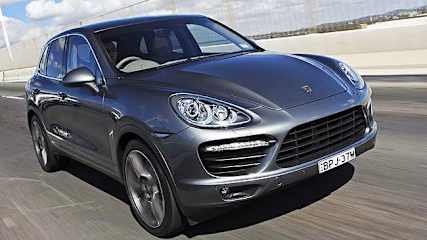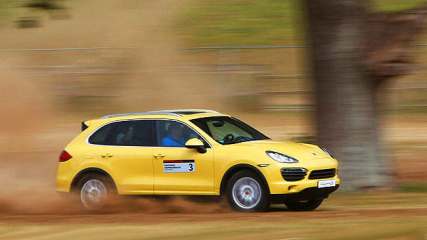Porsche Cayenne 2010 review: snapshot
By Philip King · 24 Jul 2010
NOTHING symbolises the irony of recent events at Porsche like its luxury SUV, the Cayenne. Its genesis, a decade or so ago, was a realisation within the company that it needed a mainstream model to iron out the fluctuations in sportscar demand.“After the difficult times we had in the early 1990s, we believed that aside from sportscars we needed something else to stabilise the company,'' Porsche Australia boss Michael Winkler says. “From a business and a strategic perspective it was the right decision.''It wasn't the first time a Porsche model had been co-developed with Volkswagen, but it was the first time the brand had dabbled in a segment other than sportscars. Porsche enthusiasts viewed it with alarm. The company justified the move as the best way to ensure that its sportscars would continue to get the development budgets they need. And when buyers snapped up the Cayenne -- nearly 50,000 were sold in its peak year, half of total output and double expectations -- it looked like genius. Porsche became the most profitable car company on the planet.However, it had solved one problem only to create another. Half of its sales now relied on a car that underneath was a Volkswagen Touareg. If Volkswagen changed hands or, for whatever reason, terminated its co-operation, then Porsche would again be in trouble. So the Cayenne effectively gave Porsche both the motivation and the means to attempt its ill-fated takeover of Volkswagen.That daring move became mired in debt and a year ago Volkswagen turned the tables, acquiring Porsche instead.Although the smoke is still clearing on what that means for Porsche, one consequence is likely to be a plethora of new models, with many sharing Volkswagen components. With the Cayenne, Porsche showed the potential of just this sort of brand stretching.From Porsche's perspective the irony is doubly chilling because as one of Volkswagen's stable of 10 brands, it no longer needs the stability and volume brought by the Cayenne. Volkswagen has shown with its stewardship of Bugatti, Bentley and Lamborghini that it's big enough to wear the uneven costs and cash flow of elite brands.Last week, a few days after Volkswagen announced it would install its own production strategist as head of Porsche, the local outfit was launching the second generation of the Cayenne. It looks similar to the original but, seven years after its debut, this reworking is about as complete as it gets.As before, the platform is shared with the Touareg and this model extends the engineering overlap further into the engine bay as well, with the first hybrid driveline offered by Porsche identical to the one that recently premiered in Europe in the Volkswagen. The V6 petrol and diesel units, which arrive next month, are also shared, while as before there are two Porsche-developed V8s, one turbocharged.All are more efficient -- by 20 per cent or better -- with hybrid-type fuel-savings strategies deployed across the range. These include stop-start during idle on the new eight-speed transmission, a world first for a torque converter automatic. The car is bigger, with more space in a completely redesigned cabin and a larger cargo area.An aggressive weight-saving regime, which includes new magnesium components and extensive use of aluminium panels, has removed 160kg or more and means the hybrid, the heaviest, weighs less than the previous Turbo despite packing an 80kg battery under the load floor.Other changes include a reworked air suspension, larger brakes and ditching the previous foot-operated park brake in favour of an electronic unit. Two variations of all-wheel-drive system are available, with the petrol V6 and V8s paired to an active system that can direct 100 per cent of power to one axle and selectively brake wheels without traction to stop them spinning. Optional Porsche dynamic systems include active anti-roll bars, standard on Turbo.Prices have risen by $1000 in most cases, with the V6 petrol and diesel due next month setting the entry points at $103,500 and $104,500 respectively. The hybrid sits $12,000 above the naturally aspirated V8 on price, at $159,900. The Turbo remains the second most expensive SUV you can buy after the Audi Q7 diesel V12.Besides the obvious objection that it wasn't a sportscar, the Cayenne was vulnerable to criticism about its design, which attempted to mimic a 911. Porsche hasn't abandoned this strategy but it's more successful this time around. The nose has been tapered, making it appear less imposingly upright and square-cut. The headlight shapes and bonnet are similar, if not identical, to those on the Panamera. The rectangular tail-lights have also gone, replaced by amorphous units that could have come from an Audi.Most beneficial are the interior changes, which follow the layout debuted in the Panamera. Here, they represent a big lift in design appeal and material quality over the previous Cayenne and serve to separate it from the donor Volkswagen components. There's good vision all round and five dials in the instrument panel, including one that doubles as a virtual display screen.The seats are great, with rears that now slide and tilt adjust. The cargo area is well-organised with the sole disadvantage, compared to the previous car, of fixed rear glass that no longer opens independently of the tailgate.Performance is critical to the Porsche brand and the weight savings on the Cayenne show up in improved sprint figures. The Turbo becomes a sub-five-second car to 100km/h, at 4.7 seconds, while the S dips under six seconds. The Hybrid is quicker than both the V6s, at 6.5 seconds to100km/h, and can reach a higher top speed too, of 242km/h. It's also much quicker than the only other hybrid SUV available here, the Lexus RX450h, which needs 7.8 seconds to hit the legal limit.The V8s sound good, with the Turbo emitting a low, visceral grumble that's addictive. It's performance is effortless, as you are entitled to expect from a Porsche bearing the Turbo badge. The standard V8 needs to work up hills and out of slow corners, with plenty of revs. Only here did I need to use the paddles to downchange: the rest of the time the transmission can be left alone. The stop-start function feels sufficiently refined to be left on permanently.Porsche's first Hybrid wasn't the revelation I'd been hoping for; it piles on speed almost as effectively as the V8s but to a higher pitched, more complex soundtrack. Graphics on the central screen ape Toyota hybrids by showing when the engine is being assisted by the electric motor, when it's recharging and so on, although following the dancing lines of arrowheads is impossible if your eyes are on the road.Around town it offers efficiency advantages over all the variants bar the V6 diesel, but on the open roads of Queensland the numbers didn't flatter it. It also seemed a bit less assured dynamically, at least compared to the V8s, and a bit less certain in its body movements.Perhaps that's because the V8s are outstanding on this score and would outhandle many smaller vehicles with their remarkably car-like dynamics. They turn into corners eagerly, without lurching but with a chassis that actually encourages the driver. If it wasn't for the high driving position, it would be possible to forget the absurd physics of the whole situation.The steering is light but reasonably engaging and the brakes are strong enough so that you don't notice they're arresting two tonnes of high-velocity metal. The ride quality and comfort levels are high, with a nicely planted feel to the car, although road noise intrudes a bit more than is ideal. On coarse country tarmac, few cars isolate that effectively.Most surprising about the Cayenne was its ability on a small offroad track at Porsche's Mt Cotton facility. There's no low-range gearing this time -- and no extra underbody protection or offroad rubber -- but the Cayenne showed it could climb and wade as well as bush-credentialled machines. It's too polished a car for an expedition, but it's nice to know it could get you out of trouble if the circumstances arose.On its merits, this Cayenne deserves to be more successful than the last. It's more appealing, efficient and luxurious. Porsche Australia says the order bank is strong and the first three months' supply is already sold, with early interest in the Turbo. The Hybrid hopes to attract 15 per cent of buyers eventually although it feels like the Cayenne variant Porsche had to have, thanks to ever stricter efficiency regulations, rather than one that would naturally occupy its portfolio.That said, the Porsche line-up itself is likely to go places it might not have gone if the takeover bid for Volkswagen had turned out differently. And in that context, the ultimate irony of this Cayenne is that it feels more Porsche-like than ever.PORSCHE CAYENNE - $147,900 (S) to $239,900 (Turbo)Read more about prestige motoring at The Australian.


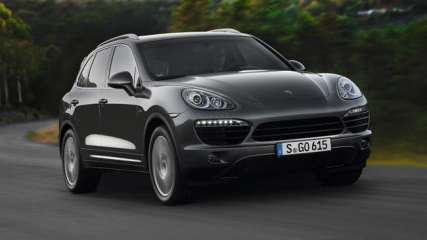
-w.jpg)
